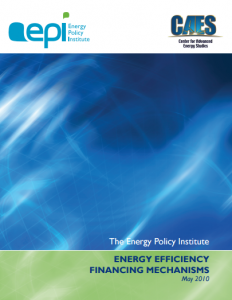Full Title: Energy Efficiency Financing Mechanisms
Author(s): Kathy Hurley, Michael Lou, and David Solan
Publisher(s): The Energy Policy Institute and The Center for Advanced Energy Studies
Publication Date: May 1, 2010
Full Text: Download Resource
Description (excerpt):
Energy efficiency is recognized as one of the nation’s most valuable untapped energy resources. The National Action Plan for Energy Efficiency states, “Improving energy efficiency in our homes, businesses, governments, and industries … is one of the most constructive, cost effective ways to address the challenges of high energy prices, energy security and independence, air pollution, and global climate change (U.S. Environmental Protection Agency, 2006). According to various sources, the United States could meet 25-40% of energy demand through energy efficiency (Granade, 2009; American Council for an Energy-Efficient Economy, 2010). Idaho has recognized the overall cost-effectiveness of energy efficiency as a resource and made it the number one resource priority in the 2007 Idaho Energy Plan (Idaho Legislative
Council Interim Committee on Energy, Environment and Technology, 2007).
Encouraging small businesses to adopt energy efficiency measures is especially challenging due to the large participation rates necessary to make a meaningful contribution toward meeting demand through efficiency rather than new generation. Given that the primary barrier for small businesses to reach widespread adoption is financing the initial cost, and that the number and variation of circumstances are large, the adoption of a one-size-fits-all approach is problematic. The states that are effectively tapping into energy efficiency as a resource use several funding mechanisms that range from rebates and tax credits to 100% upfront financing in order to encourage increased participation.
This report presents several funding options used by other states to encourage small businesses to invest in energy efficiency measures. It characterizes the different mechanisms and funding sources and presents some generalized models as part of the analysis, including advantages and disadvantages of each. These characteristics include: level of funding, timing of funding, type of funding, repayment mechanism, and responsibility for repayment. The report also provides
a synopsis of options currently available in Idaho and identifies some of the gaps that the options presented could potentially fill.
